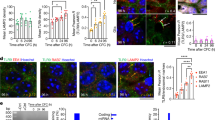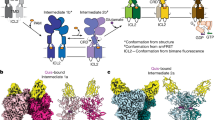Abstract
Regulated exocytosis is essential for many biological processes and many components of the protein trafficking machinery are ubiquitous. However, there are also exceptions, such as SNAP-25, a neuron-specific SNARE protein that is essential for synaptic vesicle release from presynaptic nerve terminals. In contrast, SNAP-23 is a ubiquitously expressed SNAP-25 homolog that is critical for regulated exocytosis in non-neuronal cells. However, the role of SNAP-23 in neurons has not been elucidated. We found that SNAP-23 was enriched in dendritic spines and colocalized with constituents of the postsynaptic density, whereas SNAP-25 was restricted to axons. In addition, loss of SNAP-23 using genetically altered mice or shRNA targeted to SNAP-23 led to a marked decrease in NMDA receptor surface expression and NMDA receptor currents, whereas loss of SNAP-25 did not. SNAP-23 is therefore important for the functional regulation of postsynaptic glutamate receptors.
This is a preview of subscription content, access via your institution
Access options
Subscribe to this journal
Receive 12 print issues and online access
$209.00 per year
only $17.42 per issue
Buy this article
- Purchase on Springer Link
- Instant access to full article PDF
Prices may be subject to local taxes which are calculated during checkout






Similar content being viewed by others
References
Mayer, A. Membrane fusion in eukaryotic cells. Annu. Rev. Cell Dev. Biol. 18, 289–314 (2002).
Jahn, R. & Sudhof, T.C. Membrane fusion and exocytosis. Annu. Rev. Biochem. 68, 863–911 (1999).
Jahn, R. & Scheller, R.H. SNAREs - engines for membrane fusion. Nat. Rev. Mol. Cell Biol. 7, 631–643 (2006).
Lin, R.C. & Scheller, R.H. Mechanisms of synaptic vesicle exocytosis. Annu. Rev. Cell Dev. Biol. 16, 19–49 (2000).
Duc, C. & Catsicas, S. Ultrastructural localization of SNAP-25 within the rat spinal cord and peripheral nervous system. J. Comp. Neurol. 356, 152–163 (1995).
Oyler, G.A. et al. The identification of a novel synaptosomal-associated protein, SNAP-25, differentially expressed by neuronal subpopulations. J. Cell Biol. 109, 3039–3052 (1989).
Tao-Cheng, J.H., Du, J. & McBain, C.J. Snap-25 is polarized to axons and abundant along the axolemma: an immunogold study of intact neurons. J. Neurocytol. 29, 67–77 (2000).
Washbourne, P. et al. Genetic ablation of the t-SNARE SNAP-25 distinguishes mechanisms of neuroexocytosis. Nat. Neurosci. 5, 19–26 (2002).
Ravichandran, V., Chawla, A. & Roche, P.A. Identification of a novel syntaxin- and synaptobrevin/VAMP-binding protein, SNAP-23, expressed in non-neuronal tissues. J. Biol. Chem. 271, 13300–13303 (1996).
Chen, D., Bernstein, A.M., Lemons, P.P. & Whiteheart, S.W. Molecular mechanisms of platelet exocytosis: role of SNAP-23 and syntaxin 2 in dense core granule release. Blood 95, 921–929 (2000).
Foster, L.J., Yaworsky, K., Trimble, W.S. & Klip, A. SNAP23 promotes insulin-dependent glucose uptake in 3T3–L1 adipocytes: possible interaction with cytoskeleton. Am. J. Physiol. 276, 1108–1114 (1999).
Guo, Z., Turner, C. & Castle, D. Relocation of the t-SNARE SNAP-23 from lamellipodia-like cell surface projections regulates compound exocytosis in mast cells. Cell 94, 537–548 (1998).
Vaidyanathan, V.V., Puri, N. & Roche, P.A. The last exon of SNAP-23 regulates granule exocytosis from mast cells. J. Biol. Chem. 276, 25101–25106 (2001).
Bragina, L. et al. Heterogeneity of glutamatergic and GABAergic release machinery in cerebral cortex. Neuroscience 146, 1829–1840 (2007).
Chen, D., Minger, S.L., Honer, W.G. & Whiteheart, S.W. Organization of the secretory machinery in the rodent brain: distribution of the t-SNAREs, SNAP-25 and SNAP-23. Brain Res. 831, 11–24 (1999).
Verderio, C. et al. SNAP-25 modulation of calcium dynamics underlies differences in GABAergic and glutamatergic responsiveness to depolarization. Neuron 41, 599–610 (2004).
Sadoul, K. et al. SNAP-23 is not cleaved by botulinum neurotoxin E and can replace SNAP-25 in the process of insulin secretion. J. Biol. Chem. 272, 33023–33027 (1997).
Lau, C.G. & Zukin, R.S. NMDA receptor trafficking in synaptic plasticity and neuropsychiatric disorders. Nat. Rev. Neurosci. 8, 413–426 (2007).
Wenthold, R.J., Prybylowski, K., Standley, S., Sans, N. & Petralia, R.S. Trafficking of NMDA receptors. Annu. Rev. Pharmacol. Toxicol. 43, 335–358 (2003).
Groc, L. & Choquet, D. AMPA and NMDA glutamate receptor trafficking: multiple roads for reaching and leaving the synapse. Cell Tissue Res. 326, 423–438 (2006).
Roche, K.W. et al. Molecular determinants of NMDA receptor internalization. Nat. Neurosci. 4, 794–802 (2001).
Lavezzari, G., McCallum, J., Dewey, C.M. & Roche, K.W. Subunit-specific regulation of NMDA receptor endocytosis. J. Neurosci. 24, 6383–6391 (2004).
Sans, N. et al. NMDA receptor trafficking through an interaction between PDZ proteins and the exocyst complex. Nat. Cell Biol. 5, 520–530 (2003).
Washbourne, P., Liu, X.B., Jones, E.G. & McAllister, A.K. Cycling of NMDA receptors during trafficking in neurons before synapse formation. J. Neurosci. 24, 8253–8264 (2004).
Tovar, K.R. & Westbrook, G.L. Mobile NMDA receptors at hippocampal synapses. Neuron 34, 255–264 (2002).
Oyler, G.A., Polli, J.W., Wilson, M.C. & Billingsley, M.L. Developmental expression of the 25-kDa synaptosomal-associated protein (SNAP-25) in rat brain. Proc. Natl. Acad. Sci. USA 88, 5247–5251 (1991).
Vaidyanathan, V.V. & Roche, P.A. Structure and chromosomal localization of the mouse Snap23 gene. Gene 247, 181–189 (2000).
Cahill, A.L., Herring, B.E. & Fox, A.P. Stable silencing of SNAP-25 in PC12 cells by RNA interference. BMC Neurosci. 7, 9 (2006).
Scott, D.B., Michailidis, I., Mu, Y., Logothetis, D. & Ehlers, M.D. Endocytosis and degradative sorting of NMDA receptors by conserved membrane-proximal signals. J. Neurosci. 24, 7096–7109 (2004).
Sutton, R.B., Fasshauer, D., Jahn, R. & Brunger, A.T. Crystal structure of a SNARE complex involved in synaptic exocytosis at 2.4 angstrom resolution. Nature 395, 347–353 (1998).
Leung, S.M., Chen, D., DasGupta, B.R., Whiteheart, S.W. & Apodaca, G. SNAP-23 requirement for transferrin recycling in Streptolysin-O-permeabilized Madin-Darby canine kidney cells. J. Biol. Chem. 273, 17732–17741 (1998).
Lledo, P.M., Zhang, X., Sudhof, T.C., Malenka, R.C. & Nicoll, R.A. Postsynaptic membrane fusion and long-term potentiation. Science 279, 399–403 (1998).
Nishimune, A. et al. NSF binding to GluR2 regulates synaptic transmission. Neuron 21, 87–97 (1998).
Osten, P. et al. The AMPA receptor GluR2 C terminus can mediate a reversible, ATP-dependent interaction with NSF and alpha- and beta-SNAPs. Neuron 21, 99–110 (1998).
Song, I. et al. Interaction of the N-ethylmaleimide–sensitive factor with AMPA receptors. Neuron 21, 393–400 (1998).
Lan, J.Y. et al. Protein kinase C modulates NMDA receptor trafficking and gating. Nat. Neurosci. 4, 382–390 (2001).
Lan, J.Y. et al. Activation of metabotropic glutamate receptor 1 accelerates NMDA receptor trafficking. J. Neurosci. 21, 6058–6068 (2001).
Lüscher, C. et al. Role of AMPA receptor cycling in synaptic transmission and plasticity. Neuron 24, 649–658 (1999).
Selak, S. et al. A role for SNAP25 in internalization of kainate receptors and synaptic plasticity. Neuron 63, 357–371 (2009).
Hayashi, T. et al. Synaptic vesicle membrane fusion complex: action of clostridial neurotoxins on assembly. EMBO J. 13, 5051–5061 (1994).
Petralia, R.S., Sans, N., Wang, Y.X. & Wenthold, R.J. Ontogeny of postsynaptic density proteins at glutamatergic synapses. Mol. Cell. Neurosci. 29, 436–452 (2005).
Petralia, R.S., Wang, Y.X. & Wenthold, R.J. Internalization at glutamatergic synapses during development. Eur. J. Neurosci. 18, 3207–3217 (2003).
Petralia, R.S. & Wenthold, R.J. Immunocytochemistry of NMDA receptors. Methods Mol. Biol. 128, 73–92 (1999).
Yi, Z. et al. The role of the PDZ protein GIPC in regulating NMDA receptor trafficking. J. Neurosci. 27, 11663–11675 (2007).
Carlin, R.K., Grab, D.J., Cohen, R.S. & Siekevitz, P. Isolation and characterization of postsynaptic densities from various brain regions: enrichment of different types of postsynaptic densities. J. Cell Biol. 86, 831–845 (1980).
Schlüter, O.M., Xu, W. & Malenka, R.C. Alternative N-terminal domains of PSD-95 and SAP97 govern activity-dependent regulation of synaptic AMPA receptor function. Neuron 51, 99–111 (2006).
Suh, Y.H. et al. Corequirement of PICK1 binding and PKC phosphorylation for stable surface expression of the metabotropic glutamate receptor mGluR7. Neuron 58, 736–748 (2008).
Terashima, A. et al. An essential role for PICK1 in NMDA receptor-dependent bidirectional synaptic plasticity. Neuron 57, 872–882 (2008).
Acknowledgements
We thank Y.-X. Wang for help with immunogold labeling, J.D. Badger II for preparing primary neuron cultures and M. Park (Stanford University) for helpful technical comments. We also thank the National Institute of Neurological Disorders and Stroke Light Imaging Facility, particularly C. Smith. In addition, we would like to acknowledge the National Institute of Neurological Disorders and Stroke sequencing facility. This research was supported by the National Cancer Institute Intramural Research Program (P.A.R.), the National Institute of Neurological Disorders and Stroke Intramural Research Program (Y.H.S. and K.W.R.), the Integrative Neural Immune Program (Y.H.S. fellowship), and the intramural program of the National Institute on Deafness and other Communication Disorders (R.S.P. and R.J.W.).
Author information
Authors and Affiliations
Contributions
P.A.R. and K.W.R. designed and supervised the experiments and wrote the manuscript. Immunogold electron microscopy was performed by R.S.P. and R.J.W. The electrophysiology study was carried out by A.T. and J.T.R.I. All other experiments were performed by Y.H.S.
Corresponding authors
Ethics declarations
Competing interests
The authors declare no competing financial interests.
Supplementary information
Supplementary Text and Figures
Supplementary Figures 1–6 and Supplementary Methods (PDF 12504 kb)
Rights and permissions
About this article
Cite this article
Suh, Y., Terashima, A., Petralia, R. et al. A neuronal role for SNAP-23 in postsynaptic glutamate receptor trafficking. Nat Neurosci 13, 338–343 (2010). https://doi.org/10.1038/nn.2488
Received:
Accepted:
Published:
Issue Date:
DOI: https://doi.org/10.1038/nn.2488
This article is cited by
-
The AMPA Receptor Subunit GluA1 is Required for CA1 Hippocampal Long-Term Potentiation but is not Essential for Synaptic Transmission
Neurochemical Research (2019)
-
Postsynaptic RIM1 modulates synaptic function by facilitating membrane delivery of recycling NMDARs in hippocampal neurons
Nature Communications (2018)
-
Evolution of complexity in the zebrafish synapse proteome
Nature Communications (2017)
-
High frequency stimulation induces sonic hedgehog release from hippocampal neurons
Scientific Reports (2017)
-
Anthocyanin-Loaded PEG-Gold Nanoparticles Enhanced the Neuroprotection of Anthocyanins in an Aβ1–42 Mouse Model of Alzheimer’s Disease
Molecular Neurobiology (2017)



